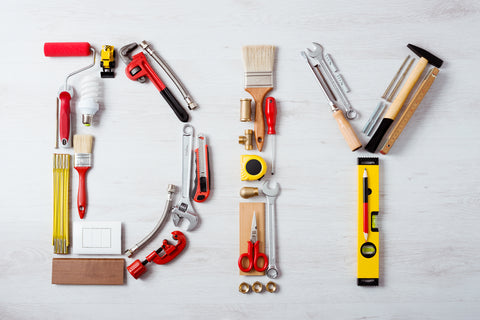Are you guilty of having a disorganized, messy workspace? It sometimes feels like toolsheds and garages explode overnight into total chaos. Organizing and cleaning time after time can feel like a major undertaking.
If you’re in the camp of professionals with a messy workspace, it’s time to create a foolproof organizational system. A workspace needs more than just ongoing cleanings. You need a process that makes it easy and streamlined to keep it organized, no matter how many workers are utilizing the space.
Having a clean, structured workspace makes you more efficient and productive because you can find items faster and have more space to work. In fact, studies show that a clean workspace creates better focus and productivity. It also improves safety because tools aren’t lying around out of place.
So what can you do to organize your workspace for a more streamlined and effective business?

1. Go through everything.
The first step is de-cluttering and categorizing. Unpack all the boxes and drawers in your workspace. Take out everything you find and put into three primary categories: keep, donate/sell, or throw out.
Within the “keep” products, you may want to further categorize and sort by similar items. For example, you might have a garden and lawn pile, a saw blade pile, and a small tools pile. You could also consider sorting by usage: which items do you use daily, weekly, monthly, or yearly? This can help you create the most streamlined workspace by storing items based on their frequency of use.
You may also want to create a list of tools that you write down as you sort. This is a great way to create an inventory for insurance and business purposes, and it makes it easier to organize in the future steps.
Tip: Make sure you label the piles as you go so you don’t forget.
While sorting, look for items that are rusted, corroded, or damaged. Determine whether they need to be sold, disposed of, or repaired.
2. Repair items.
Before throwing out items, consider if any can be repaired. Repair is usually cheaper than replacement, and proper maintenance can make your tools even better than new!
Create a separate pile for items you’ll want to be repaired. Address these repairs quickly, so the damage doesn’t worsen with time and reorganization.
If they can’t be repaired, you’ll likely need to replace them. Create a list and include these tools in your storage plan. You want to make sure to remember to include the items to be repaired and replaced so you don’t overstuff your workspace while planning for storage.
3. Get rid of what you don’t need.
Anything in the "donate/sell" or "toss" piles should go immediately. Don’t wait around to get rid of these items. The Law of Diminishing Intent says that we lose steam over time - the diminished motivation to do even the simplest of tasks can be the downfall of an organized workspace. If you wait to throw out some of your tools, you may never get around to it. They’ll end up back in your workspace causing more clutter and disorganization.
A lot of the tools you throw out can actually be restored or recycled. You can bring metal components to a scrapyard, which gives you some cash and helps keep landfills clear. Old batteries and electronics can be sold to repurposing facilities. If you can’t recycle your items, you may need to bring them to a hazardous or specialty waste facility.
Not sure how to properly and safely dispose of tools? Contact Ryker Hardware for more info.
4. Create a storage plan.
Imagine walking into your workspace. What do you need to reach first and most easily?
We usually recommend organizing based on usage. The items that you use most, like multi-tools, often should be the easiest to access.
When creating your storage strategy, consider the floor plan. Don’t forget about ceilings and walls, which can give you extra storage space. You’ll want to consider how different storage systems will work together. For example, you may want to use pegboards on the walls to store bigger items, drawers with organizers for smaller items, and plastic bins on shelving units for batteries.
You might also want to consider what would look most appealing in the space. Your workspace should make you feel comfortable. If you invited clients into your workspace, what would you want it to look like? The better your workspace looks, the more likely a client will hire you because they’ll think you are organized and professional. Looking through your clients’ eyes can help you create an attractive, streamlined storage space.
Tip: While creating your storage plan, use painters’ tape to label different areas around the garage. This will help you visualize the look and feel of the flow of the workspace. You may even want to lie out tools where they’ll go to get a general idea of what it will look like.
5. Install storage systems.
Based on your plan, you’ll need to use different systems. Thankfully, it can be easy to make your own storage units for your workspace. Below are some of our favorite DIY storage systems.

Wall pegboard: This takes all of your tools off the floor while easily and visually organizing tools. Pegs in the board are easily adjustable, so you can simply change your storage based on the lineup of your tools. It also helps you quickly see which items are missing at the end of the workday. We especially like steel pegboards, which are inexpensive, easy to clean, and look great. Learn how to install a pegboard wall with the DIY Network here.
Magnetic strips: Install a strip of magnetic tape on the wall or inside of drawers. This holds smaller tools like screw heads and drill bits. It keeps these smaller parts organized and handy, so they’re quick and easy to get to.
Blade organizer: Saw blades can be dangerously sharp, so you want to keep these especially organized. You don’t want a worker reaching their hand in and getting cut on the edge of the blade. Check out this awesome DIY table saw blade organizer.
Metal shelving: Every workspace needs a set of metal shelves that are easily accessible. This is a great way to store drawers, bins, and horizontal items. Do not get rolling shelves, as this can be unsafe; stick to stationary shelving units and keep a step stool nearby.
Plastic bins: If you’re a professional, you’ll typically want to keep paperwork in your workspace. You want easy access to user manuals, manufacturer instructions, and client contracts. Storing these in organized plastic bins protects your paper from dust and dirt. Plastic bins are also great for organizing tools that are still in their cases and protect metal from the air, which can cause corrosion and rust.
Tape dispenser: If you use duct tape in your workspace, a tape dispenser is a great way to keep these organized and easily accessible. It’s a small change that will drastically impact your workflow! Check out how to create your own DIY tape dispenser here.
Ceiling storage: Don’t forget about all that space on your ceiling. Install sturdy racks that can hold plastic bins of items you don’t use as often. Make sure you don’t store loose tools on the ceiling.
6. Get help.
You’ll likely want help from another person throughout this organization process. They can help you manufacture your DIY projects and install shelving. They will be a second pair of eyes to see if your storage plan is missing anything or isn’t completely efficient.
A few more people on your team can help make the project faster and more productive.

7. Put things in place.
The hardest part is actually putting items in place. Sometimes the plan doesn’t go according to plan, and that’s okay. Be flexible and work around it. Take your time and don’t rush through it.
Putting that last tool in its place is one of the most satisfying feelings!
Conclusion
Cleaning your workspace can feel like a stressful undertaking. But a couple hours focusing on organization can save hundreds of hours in efficiency and productivity moving forward.
If you’re not sure which tools you need or how to properly store them, contact Ryker Hardware for more info.

Leave a comment